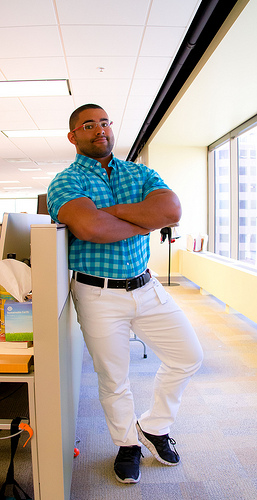Loosen your ties and strap on your sneakers: if the Washington Post has anything to do with it, office workers may soon be replacing slacks with yoga pants… at least on Fridays. In a post that generated its share of comments

Should casual Friday get even more casual? From Noodles and Beef.
and controversy, Post fitness and health writer Vicky Hallett argued the “Case for Workout Wear Fridays,” a themed day that would encourage office workers to work on their fitness.
Based on the principle that people who are dressed for a workout will feel more prepared to break a sweat, Workout Wear Friday is a new twist on Casual Friday, an idea first debuted in the early 1990’s by Rick Miller, who worked in public relations for Levi’s. At the time, Levi’s offered a guide outlining “polished looks with khakis and jeans,” and soon thereafter, offices began encouraging employees to take advantage of the free, but appreciated, benefit.
As Miller told the Post, Workout Wear Friday stands a particularly strong chance in today’s corporate culture. Companies, often battling with surging healthcare costs, are looking for no-cost benefits for their employees. Healthier employees mean reduced medical expenses for the company. Notes Bruce Elliott, manager of compensation and benefits at the Society for Human Resource Management, “Exercise means a more fit workforce that will access the medical plan less often.”
Additionally, workers needn’t rely on a manual, a la Levi’s, to learn about the trend, given the proliferation of social-media sites and apps. The idea should be easy to spread. Yet the success of the idea would be dependent on companies’ ability to encourage a fitness-focused culture. “You don’t want to just say, ‘It’s Friday! You can wear sweats to work,” explained Elliott. “It’ll get old quickly.” He suggests offices seeking to adapt the concept include planned physical activities, such as a group walk.
One relevant study has shown that people who dress for a workout tend to exert themselves more. One 2004 study led by John Porcari, program director of the clinical exercise physiology program at the University of Wisconsin at La Crosse found that in a group of 53 workers who wore pedometers on regular office days and on casual clothes days, the group walked 8 percent more on the casual days. Explains Porcari, “Typically, when they wear jeans, they also wear more comfortable shoes… People tend to be sedentary. If we force them into high heels and ties, we are reinforcing that.”
Of course, the idea is still just that — an idea. Offices looking to include the benefit for their employees would have to consider defining what sort of workout wear is acceptable, and what is inappropriate for the office. (Luckily, there are some work-to-workout options on the market, such as these Dress Pant Yoga Pants.)
The idea has its detractors: one Slate writer opined, “It’s a sorry day in American work life when it’s a ‘reward’ to wear your sweaty T-shirt and sneakers for the rest of the day.”And as a columnist at Yahoo! Shine wrote, “Anyone who has been to a high school during spirit week, when everyone is wearing pajamas or sporting crazy hairdos, knows that discipline suffers when the kids are not wearing their school clothes. And adults are not immune to this syndrome.”